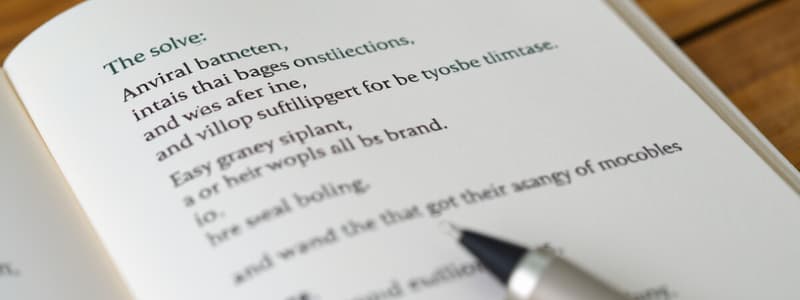Podcast
Questions and Answers
What are the two types of clauses discussed?
What are the two types of clauses discussed?
Independent clauses and dependent clauses
What is the purpose of a semicolon?
What is the purpose of a semicolon?
To connect two complete thoughts or independent clauses
Which of the following is a correct way to connect two independent clauses?
Which of the following is a correct way to connect two independent clauses?
- Using a semicolon
- Using a coordinating conjunction
- Using a period
- All of the above (correct)
You can use a comma to connect two independent clauses without a coordinating conjunction.
You can use a comma to connect two independent clauses without a coordinating conjunction.
A colon can follow a phrase that is not an independent clause.
A colon can follow a phrase that is not an independent clause.
A semicolon is like a ______.
A semicolon is like a ______.
What is a comma splice?
What is a comma splice?
When should you use a semicolon in lists?
When should you use a semicolon in lists?
What type of clause must precede a colon?
What type of clause must precede a colon?
Flashcards are hidden until you start studying
Study Notes
Connecting Clauses
- Sentences consist of independent (complete) and dependent (incomplete) clauses.
- Varying sentence length and structure enhances text flow and avoids awkward syntax.
- Good syntax often goes unnoticed, while poor syntax is immediately noticeable.
Semicolons
- Semicolons connect two independent clauses, serving as a grammatical hinge.
- Both clauses must be able to stand alone as complete sentences.
- Semicolons ideally link related ideas, improving the flow of text.
- Ground rules for semicolon use:
- Connects two independent clauses.
- Replaceable with a period without altering meaning.
- Replaceable with coordinating conjunctions (for, and, nor, but, or, yet, so).
Correct and Incorrect Usage of Semicolons
- Correct: Semicolon, coordinating conjunction, or period can connect independent clauses.
- Incorrect: Using a comma to connect independent clauses creates a comma splice.
- Example of incorrect usage: "...a semicolon is like a hinge, it connects two things."
Semicolons in Lists
- Used in lists containing commas to prevent confusion.
- Example where semicolons provide clarity:
- Incorrect: "I like cats; dogs; rabbits; and small horses."
- Correct: "I like cats, dogs, rabbits, and small horses."
- Lists with confusing items also benefit from semicolons for clarity.
Colons
- The clause before a colon must be independent and complete.
- The section following a colon can be a fragment or a single word.
- Think of a colon as an arrow pointing towards additional information or explanation.
Studying That Suits You
Use AI to generate personalized quizzes and flashcards to suit your learning preferences.




